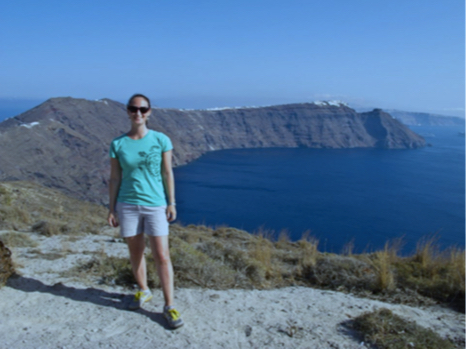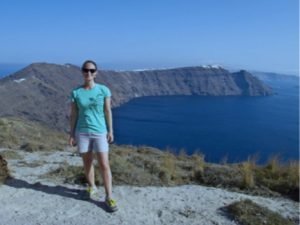Sarah Conway
Meniscal allograft transplantation
While I was living in London to pursue a Master’s degree at the London School of Economics & Political Science, I found Ian at the 31 Old Broad Street practice. My knee had been bothering me quite a bit in the weeks prior and I was feeling increasingly concerned about its state. Over the two and a half year period before moving to London I had undergone five knee operations in Singapore: two medial meniscus repairs, two partial meniscectomies, and one ACL reconstruction. The initial injury was caused during a minor motorbike accident in Bali where I resided at the time. The subsequent injuries were all somewhat random, minor, unlucky incidents. I was fairly convinced that I had a strange affinity for medial meniscus problems, especially since I’d had three medial meniscus operations on my other knee when I was younger (due to football injuries).
Upon arrival at 31 Old Broad Street I felt at ease: the receptionists were friendly and warm, and I was immediately brought back to Ian’s office. During our initial visit I explained my somewhat long and complicated history while Ian listened and took copious notes. After examining the knee he decided that the next step would be to have an MRI to gain further clarity on the state of my knee. I scheduled the MRI for a few days later and returned to see Ian later that same day. The MRI confirmed Ian’s suspicion that I no longer had any functional medial meniscus left. Upon hearing this I assumed he would immediately recommend a meniscal allograft transplantation. His approach, however, was much more grounded in educating me on meniscal allograft transplantations than on convincing me as to why I needed one. While I exhibited the characteristics of a “good candidate,” he was very clear that the decision to pursue the path had to come from me: due to the long recovery time and physiotherapy commitment required it is not a decision to take lightly. He was also very balanced in his review of the advantages and limitations of the operation: certainly having a meniscus is better than not having one at all, but the cadaver meniscus would never be as strong as my original had been, and I would have to accept and acknowledge this as I engaged in physical activity moving forward. I found his approach, driven by thoughtful and clear education, refreshing. Ultimately I decided that I could commit to the lengthy recovery process in hopes that my knee pain would decline and that I would avoid future arthritis.
Ian and his team worked diligently to coordinate with the tissue bank in the U.S., my insurance company, and the London Bridge Hospital. It was impossible to predict with certainty as to when a tissue match would be secured, but Ian and his team kept me informed and as soon as a tissue was found they confirmed the operation day and time.
When I arrived at the hospital and checked in, Ian visited my room to go over the specifics of the procedure one more time. Again I sincerely appreciated that he took the time to thoughtfully explain everything and answer questions. The anesthesiologist also came by to review the procedure and post-op pain management regimen. Before I knew it the operation was over and I was back in my hospital room with a knee brace on. Everything had gone well and I was now able to relax, watch movies, and surf the internet while recovering at the hospital overnight.
Once back at my flat I spent the first week resting and recuperating. The swelling and pain levels were helped by my frequent use of the Game Ready machine, yet another one of Ian’s fabulous recommendations.
Walking with crutches (non-weight-bearing) for six weeks was certainly not easy, but I managed to get around London just fine. I saw Ian two weeks post-op and he was very pleased with my low level of swelling (thanks, Game Ready!) and minimal muscle atrophy. At the six week follow-up he adjusted my knee brace to allow for further range-of-motion and recommended a timeline for increasing weight- bearing and reducing my use of crutches. He also put me in touch with a nearby physiotherapist. The physiotherapist, Robert Kavanagh, was absolutely superb and I worked with him 2-3 times per week for several months. The combination of Rob’s encouragement and advice, coupled with Ian’s ongoing support via email were great and exactly what I needed to ensure a slow but steady and successful recovery. It wasn’t always easy: getting the range of motion back and beginning to build up muscle mass in my leg was difficult and at times quite
painful. But I listed to Rob and Ian and wholeheartedly trusted them to provide sound advice and care. I also did my best to be patient and to accept that seeing results takes time. At Ian’s suggestion, I rented a Kneehab XP to assist in my quadriceps strengthening, and I found it to be a good complement to my ongoing physiotherapy exercises. At my three-month post-op appointment, Ian was complementary of my impressive progress. I continued with physiotherapy though completed most of it on my own. By the five-month point I was walking and hiking with minimal to no pain.
The months that followed were reasonably smooth and now, exactly one-year post-op, my knee feels really solid. It still flares up now and again but generally feels much better than it did before the operation. I cannot thank Ian and Rob enough for their thoughtful support and care.
I highly recommend Ian if you are considering a meniscal allograft transplantation. He was extremely measured during our discussions about my options before the operation, did a fantastic job during the operation, and has remained available and responsive via email since then. If you decide to pursue this path, I encourage you to rent a Game Ready for the first month post-op, to find a physiotherapist that will be supportive but that you trust to push you slightly out of your comfort zone, and to just be patient. It may be frustrating at times, but with a good attitude and diligent commitment to physiotherapy, it is well worth the effort!
Sarah Conway April 2013
March 2017


